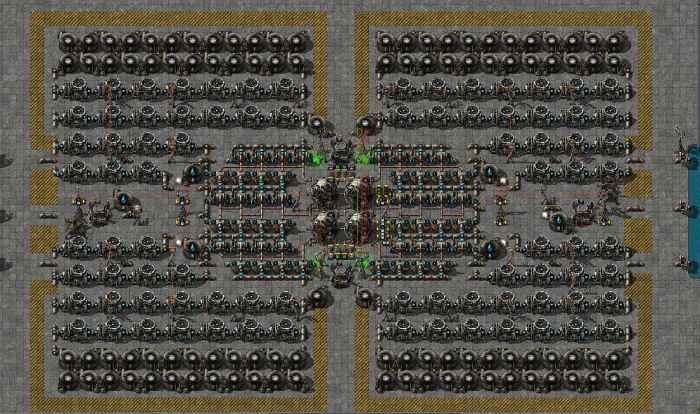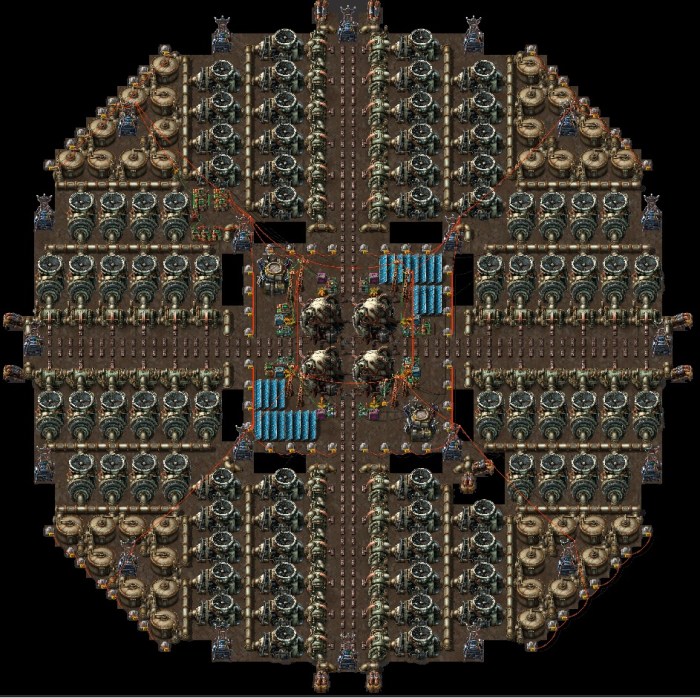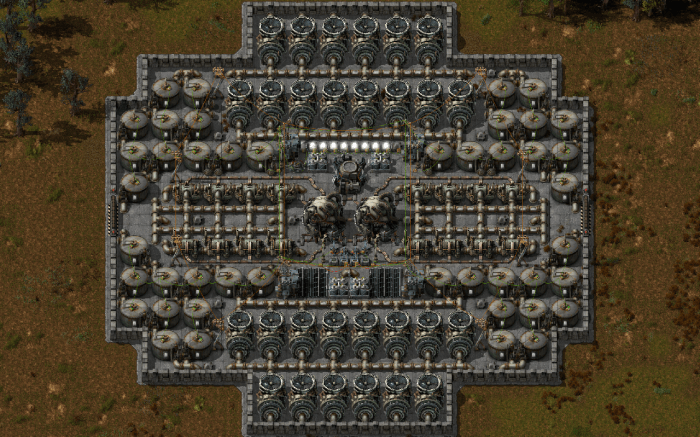Embark on an enlightening journey into the captivating realm of Factorio nuclear reactors, where we unravel the intricate mechanics, delve into fuel management, explore design intricacies, and uncover the complexities of power generation. Brace yourself for a comprehensive exploration that will illuminate the depths of this technological marvel.
At the heart of nuclear reactors lies the fundamental principle of harnessing the energy released from nuclear reactions. Understanding the components and types of reactors provides a solid foundation for appreciating their diverse applications.
Nuclear Reactor Mechanics

Nuclear reactors are devices that control the release of energy from nuclear reactions. They are used to generate electricity, power submarines and spacecraft, and produce radioactive isotopes for medical and industrial uses.
The basic principle of a nuclear reactor is to create a controlled chain reaction of nuclear fission. Fission is the process of splitting a heavy nucleus, such as uranium or plutonium, into two smaller nuclei, releasing a great amount of energy.
This energy is used to heat water, which turns into steam and drives a turbine that generates electricity.
Diagram of a Typical Nuclear Reactor
A typical nuclear reactor consists of the following components:
- Fuel:The fuel for a nuclear reactor is typically uranium or plutonium.
- Moderator:The moderator is a material that slows down neutrons, which increases the likelihood of them causing fission.
- Control rods:Control rods are used to control the rate of fission by absorbing neutrons.
- Coolant:The coolant is a fluid that removes heat from the reactor core.
- Pressure vessel:The pressure vessel is a thick-walled container that houses the reactor core.
- Turbine:The turbine is a device that converts the heat from the steam into electricity.
Types of Nuclear Reactors
There are many different types of nuclear reactors, each with its own advantages and disadvantages. Some of the most common types of reactors include:
- Pressurized water reactors (PWRs):PWRs are the most common type of nuclear reactor in the world. They use ordinary water as both the coolant and the moderator.
- Boiling water reactors (BWRs):BWRs use ordinary water as the coolant, but they allow the water to boil inside the reactor core. This produces steam directly, which is then used to drive the turbine.
- Heavy water reactors (HWRs):HWRs use heavy water as the moderator. Heavy water is a more effective moderator than ordinary water, which allows HWRs to use natural uranium as fuel.
- Gas-cooled reactors (GCRs):GCRs use carbon dioxide or helium as the coolant. GCRs are often used in high-temperature applications, such as for producing hydrogen.
Reactor Design and Safety

Nuclear reactors are complex and highly engineered systems that require careful design and safety considerations. The key design elements of a nuclear reactor include materials, shielding, and cooling systems.
Materials
The materials used in a nuclear reactor must be able to withstand the extreme conditions of high temperature, radiation, and pressure. The reactor core, where the nuclear reactions take place, is typically made of uranium or plutonium fuel rods. These rods are clad in a protective material, such as zirconium alloy, to prevent the release of radioactive material.
Shielding
Nuclear reactors are shielded to protect workers and the environment from radiation. The shielding material, typically concrete or water, absorbs and scatters radiation, reducing its intensity. The thickness of the shielding depends on the type of reactor and the amount of radiation produced.
Cooling Systems
Nuclear reactors generate a tremendous amount of heat, which must be removed to prevent the reactor from overheating. The cooling system circulates a coolant, such as water or liquid sodium, through the reactor core. The coolant absorbs the heat and carries it away to a heat exchanger, where it is transferred to a secondary coolant loop.
The secondary coolant is then cooled and returned to the reactor core.
Safety Systems
Nuclear reactors are equipped with a variety of safety systems to prevent and mitigate accidents. These systems include:
- Emergency shutdown systems:These systems can automatically shut down the reactor in the event of an emergency.
- Containment structures:These structures are designed to prevent the release of radioactive material into the environment in the event of an accident.
- Radiation monitoring systems:These systems monitor the levels of radiation in the reactor and the surrounding area.
Safety Protocols
In addition to safety systems, nuclear reactors are subject to strict safety protocols. These protocols include:
- Regular inspections and maintenance:Reactors are regularly inspected and maintained to ensure that they are operating safely.
- Operator training:Reactor operators are highly trained and certified to ensure that they can safely operate the reactor.
- Emergency response plans:Emergency response plans are in place to ensure that the reactor can be safely shut down and any accidents can be mitigated.
Nuclear Reactor Accidents
Despite the safety systems and protocols in place, nuclear reactor accidents have occurred. Some of the most notable accidents include:
- Three Mile Island (1979):A partial meltdown of the reactor core occurred due to a series of equipment failures and human errors.
- Chernobyl (1986):A catastrophic explosion and fire occurred at the reactor, releasing large amounts of radioactive material into the environment.
- Fukushima Daiichi (2011):A massive earthquake and tsunami caused a loss of power and cooling systems, leading to a meltdown of the reactor cores.
These accidents have led to significant improvements in nuclear reactor safety. Lessons learned from these accidents have been incorporated into the design and operation of new reactors, and safety protocols have been strengthened.
Power Generation and Efficiency

Nuclear reactors generate electricity through a process called nuclear fission. In nuclear fission, the nucleus of an atom is split into two smaller nuclei, releasing a great amount of energy. This energy is used to heat water, which turns into steam.
The steam drives a turbine, which generates electricity.
Factors Affecting Efficiency
The efficiency of a nuclear reactor is determined by several factors, including the type of fuel used, the design of the reactor, and the operating conditions. The most common type of fuel used in nuclear reactors is uranium-235. Uranium-235 is a fissile isotope, which means that it can be split apart by neutrons.
The design of the reactor affects how efficiently the neutrons are used to split uranium-235. The operating conditions, such as the temperature and pressure of the water, also affect the efficiency of the reactor.
Comparison to Other Energy Sources
Nuclear reactors are more efficient than most other energy sources. The efficiency of a nuclear reactor is typically around 30%, compared to around 25% for coal-fired power plants and 10% for solar panels. This means that nuclear reactors can generate more electricity with less fuel.
Future of Nuclear Energy
Nuclear energy is poised to play a significant role in the future global energy mix, as it offers a clean, reliable, and efficient source of power. Advancements in nuclear reactor technology, such as the development of smaller, modular reactors and the use of advanced fuels, are making nuclear energy more accessible and cost-effective.
Advancements in Reactor Technology
* The development of small modular reactors (SMRs) is a significant advancement in nuclear reactor technology. SMRs are smaller and more flexible than traditional nuclear reactors, making them more suitable for a wider range of applications.
Advanced fuels, such as uranium-thorium fuel, have the potential to improve the efficiency and safety of nuclear reactors.
Role in Global Energy Mix, Factorio nuclear reactor
* Nuclear energy is expected to play a major role in the global energy mix, as it provides a reliable and carbon-free source of power.
The International Energy Agency (IEA) estimates that nuclear energy will account for around 12% of global electricity generation by 2050.
Concluding Remarks: Factorio Nuclear Reactor
As we conclude our exploration of Factorio nuclear reactors, it is evident that these technological marvels hold immense potential for shaping the future of energy. With advancements in design and safety, nuclear reactors continue to play a crucial role in the global energy mix, offering a clean and efficient alternative to traditional fossil fuels.
As we navigate the challenges of waste management and environmental impact, ongoing innovations promise to pave the way for a sustainable and prosperous future powered by nuclear energy.
Query Resolution
What are the key safety measures implemented in Factorio nuclear reactors?
Factorio nuclear reactors employ multiple layers of safety systems, including containment structures, cooling systems, and automated shutdown mechanisms. These measures are designed to prevent and mitigate potential accidents, ensuring the safe operation of the reactors.
How does a Factorio nuclear reactor generate electricity?
Factorio nuclear reactors generate electricity through a process called nuclear fission. In this process, uranium atoms are split apart, releasing a tremendous amount of energy in the form of heat. This heat is used to create steam, which drives turbines connected to generators, producing electricity.
What are the different types of radioactive waste produced by Factorio nuclear reactors?
Factorio nuclear reactors produce two main types of radioactive waste: low-level waste and high-level waste. Low-level waste consists of materials that have been contaminated with small amounts of radioactivity, while high-level waste contains highly radioactive materials that require specialized handling and disposal.